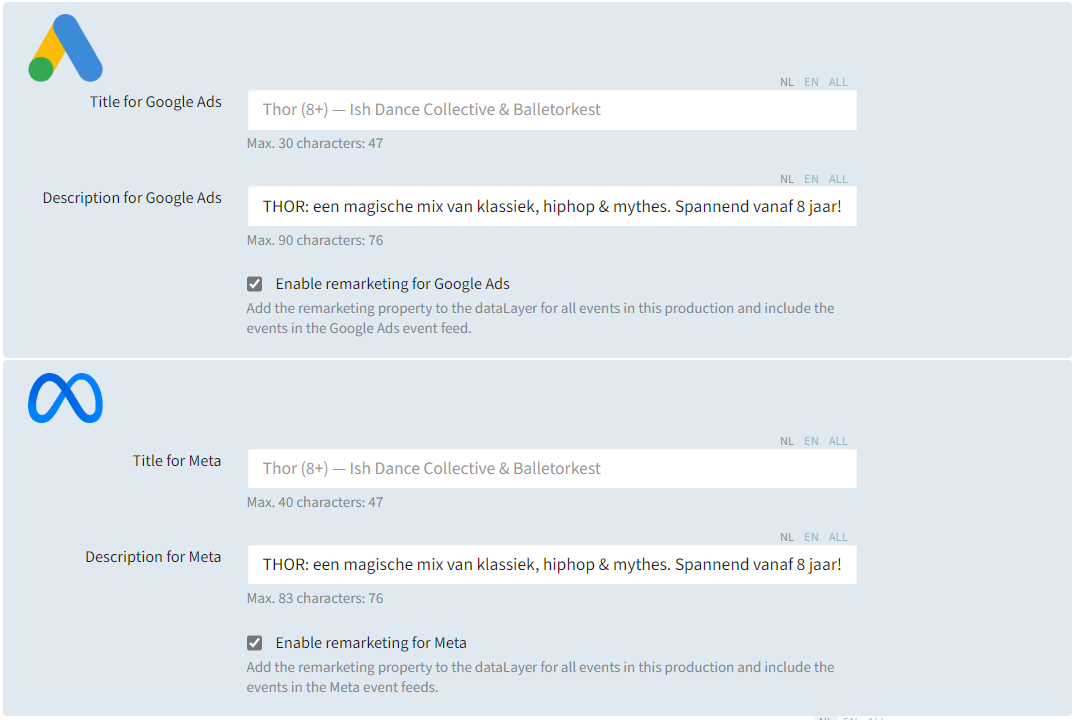In today’s digital world, our attention is a scarce resource. For cultural organisations, this creates a major challenge: how do you stand out and connect with an audience that’s constantly bombarded with content?
The answer lies in personalisation. By showing people the performances they’re most interested in, you can cut through the noise and turn casual website visitors into dedicated patrons. That’s exactly what we achieved with Amare – one of the Netherlands’ premier performing arts venues – by implementing a powerful dynamic remarketing strategy.
What is a Dynamic Remarketing feed?
At its core, a dynamic remarketing feed is a digital catalog of your offerings. For Amare, this feed is a live list of all their performances, containing crucial data like titles, artists, descriptions, dates, and ticket prices.
The key is that this feed is dynamic. It automatically updates whenever information changes, i.e. a new show is announced, a performance sells out, or a date is changed. This ensures your ads are always accurate and relevant. Advertising platforms like Google and Meta use this data to instantly generate personalised ads based on what visitors have browsed on your website.
Beyond personalisation: The business impact
The benefits of a dynamic feed extend far beyond simply showing the right ad. For cultural organisations, the strategic advantages are immense.
- For Marketing Teams: This solution dramatically increases efficiency. Instead of manually creating hundreds of ad variations for each performance, the feed handles the heavy lifting. This frees up the marketing team to focus on strategic tasks like audience segmentation, campaign analysis, and creating engaging content. It transforms a labour-intensive process into a streamlined, automated workflow.
- For Audience Development: Dynamic remarketing directly impacts the bottom line. It not only increases ticket sales but also improves the customer journey. By providing a highly relevant experience, you build trust and a stronger relationship with your audience. This can lead to higher average order values and repeat visits. Moreover, the automation ensures that even last-minute performances or changes can be promoted effectively, maximising revenue opportunities.
Dynamic Remarketing in practice with Amare
Amare and MondoMarketing have been working together for a few years now. We started to implement dynamic remarketing feeds with a clear goal: boost ticket sales by making their digital advertising more relevant. We partnered with CultureSuite – Amare’s website partner – to build the necessary technical foundation.
The setup involved two main feeds:
- For Meta: We built a dedicated XML feed. This format is specifically designed for product catalogs, allowing Meta's platform to seamlessly pull all performance data. The feed is hosted on a secure URL, which Meta checks for updates multiple times a day.
- For Google Ads: We created a Google Sheet-based feed. This solution is powered by a custom-built Google Apps Script. This script periodically pulls the latest performance data from Amare’s CMS and populates the Google Sheet. This two-way communication ensures the data in the sheet is always fresh and ready for use in Google’s Display campaigns.
The real magic happens behind the scenes. The system is directly linked to the CultureSuite CMS used by the Amare team. To include a performance in the feed, Amare simply ticks a box.

This streamlined approach has had a transformative effect on Amare's marketing results.
"The dynamic feed has greatly enhanced our audience’s online experience. By serving personalised ads, we're not just selling more tickets, with an achieved ROAS of 25.5:1 (2550%), we're creating a more relevant and engaging connection with our visitors. This level of personalisation is crucial for building lasting relationships with our community." - Henny van Haelen.
Your practical guide to getting started
Inspired by Amare's success? Here’s what you need to know to implement your own dynamic feed:
- Prepare Your Data: Compile all essential performance information: titles, dates, prices, high-quality images, and unique product IDs. This is the foundation of your feed.
- Tag Your Website: Implement a tracking pixel (like the Meta Pixel or Google Ads Tag) on your site. This pixel must pass the unique product ID of the performance a user is viewing to link their on-site behavior with the feed. Ensure the tagging is consistent and accurate across all pages.
- Choose a Platform & Build the Feed: Decide whether you'll use an XML feed for Meta, a spreadsheet for Google Ads, or both. Your developer or a website partner like CultureSuite can help you set up an automated system that connects your CMS to these feed formats.
- Ensure Automation: Your feed should automatically update by integrating directly with your CMS or ticketing system. A manual feed is not a scalable solution and can lead to errors.
- Build Your Campaigns: Once the feed is live and your site is correctly tagged, you can create dynamic remarketing campaigns within Google Ads and Meta, letting the platforms do the heavy lifting of showing the right ad to the right person. As shown in the image, check the box: "Use dynamic ads feed for personalized ads" in the campaign settings, and select the right feed.

Let’s get this show on the road
Whether you're exploring dynamic remarketing, audience development strategies, or looking for expert guidance on digital marketing for cultural venues, here's where to go next.
- Looking for more guidance on digital marketing?
MondoMarketing specialises in digital marketing strategies for cultural venues across the Netherlands and beyond. If you want to learn more about how dynamic remarketing could work for your venue, get in touch with their team or visit MondoMarketing. - Want more resources about arts, culture and technology?
Explore our industry insights and expert advice by heading over to our articles, events and webinars, Spotify, YouTube channel or subscribing to our newsletter.






